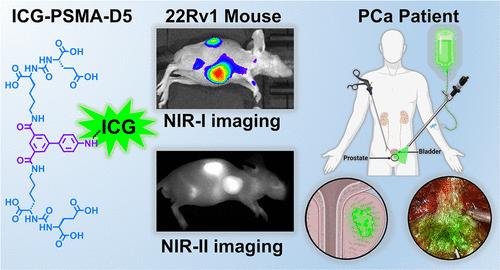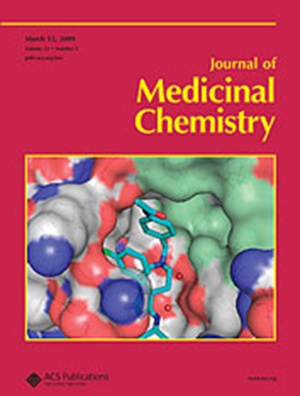ICG-PSMA-D5的合成、临床前评估和首次人体评估:一种用于前列腺癌荧光引导手术的psma靶向探针
IF 6.8
1区 医学
Q1 CHEMISTRY, MEDICINAL
引用次数: 0
摘要
由于手术切缘阳性对术后预后的影响,前列腺癌(PCa)的精确手术切除是一项重大的临床挑战。荧光引导手术(FGS)使实时肿瘤可视化使用荧光探针。在这项研究中,我们合成并评估了一种基于吲哚菁绿(ICG)的psma靶向近红外探针ICG- psma - d5,用于前列腺癌病变的术中成像。光谱分析表明,ICG- psma - d5保留了ICG的光学性质,同时由于增加了羧基而提高了在PBS中的溶解度。体外实验显示高结合亲和力(Ki = 0.39 nM)和最小的细胞毒性。在荷瘤小鼠体内的研究表明,肿瘤靶向性强,在肿瘤部位滞留时间长,生物分布良好,具有显著的肿瘤-背景比。首次在局部PCa患者中进行的人体研究表明,该探针具有实时、无辐射的手术指导潜力。总体而言,ICG-PSMA-D5在肿瘤检测和边界划定方面表现优异,是前列腺癌术中FGS的一个有希望的候选者。本文章由计算机程序翻译,如有差异,请以英文原文为准。

Synthesis, Preclinical Evaluation, and First-in-Human Assessment of ICG-PSMA-D5: A PSMA-Targeted Probe for Fluorescence-Guided Surgery of Prostate Cancer
Precise surgical resection of prostate cancer (PCa) is a significant clinical challenge due to the impact of positive surgical margins on postoperative outcomes. Fluorescence-guided surgery (FGS) enables real-time tumor visualization using fluorescent probes. In this study, we synthesized and evaluated an indocyanine green (ICG)-based PSMA-targeted near-infrared probe, ICG-PSMA-D5, for intraoperative imaging of PCa lesions. Spectroscopic analysis revealed that ICG-PSMA-D5 retained the optical properties of ICG while improving solubility in PBS due to additional carboxyl groups. In vitro assays demonstrated high binding affinity (Ki = 0.39 nM) and minimal cytotoxicity. In vivo studies in tumor-bearing mice showed strong tumor targeting, extended retention at tumor site, and favorable biodistribution, with significant tumor-to-background ratios. The first-in-human study in a patient with localized PCa indicated the probe’s potential for real-time, radiation-free surgical guidance. Overall, ICG-PSMA-D5 displayed excellent performance in tumor detection and margin delineation, making it a promising candidate for intraoperative FGS in PCa.
求助全文
通过发布文献求助,成功后即可免费获取论文全文。
去求助
来源期刊

Journal of Medicinal Chemistry
医学-医药化学
CiteScore
4.00
自引率
11.00%
发文量
804
审稿时长
1.9 months
期刊介绍:
The Journal of Medicinal Chemistry is a prestigious biweekly peer-reviewed publication that focuses on the multifaceted field of medicinal chemistry. Since its inception in 1959 as the Journal of Medicinal and Pharmaceutical Chemistry, it has evolved to become a cornerstone in the dissemination of research findings related to the design, synthesis, and development of therapeutic agents.
The Journal of Medicinal Chemistry is recognized for its significant impact in the scientific community, as evidenced by its 2022 impact factor of 7.3. This metric reflects the journal's influence and the importance of its content in shaping the future of drug discovery and development. The journal serves as a vital resource for chemists, pharmacologists, and other researchers interested in the molecular mechanisms of drug action and the optimization of therapeutic compounds.
 求助内容:
求助内容: 应助结果提醒方式:
应助结果提醒方式:


